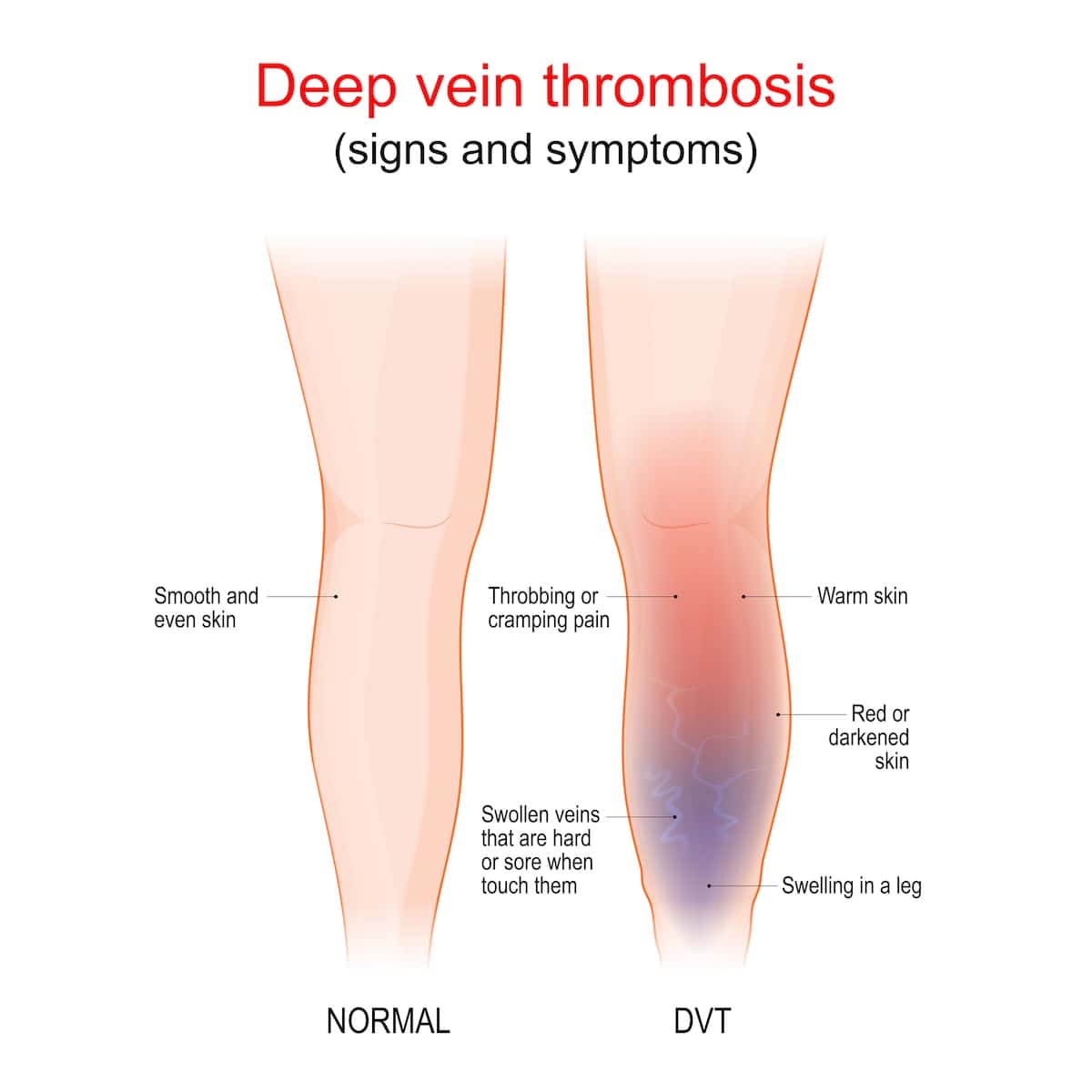Preventing DVT (Deep Vein Thrombosis) When Traveling

While the chances of it occurring are slim, preventing DTV makes sense for travelers.
If you’re anything like me, moving around the cabin is the last thing you think about during a flight. A scaredy-cat from way back, I took my first airplane ride when I was 16 and shook in my seat while gripping the armrests for six hours it took to get to our destination.
I rarely leave my seat (save for a trip or two to the restroom) and pay rapt attention to the flight attendant’s safety demonstrations (even though I try to act nonchalantly).
But there is a reason – other than to use the bathroom or go talk to a friend sitting a few rows behind you – to move around during airline travel.
Deep vein thrombosis (DVT) is a major health threat that occurs when a blood clot forms in a large vein. The outcome can be serious or even life-threatening: part of the clot may break off and travel to your lungs, causing a pulmonary embolism (PE).
It’s estimated that between 300,000 to 600,000, Americans have these conditions each year and that 60,000 to 100,000 die as a result. Aside from that, many people with either condition suffer from complications that greatly impact their health and quality of life.
While the consequences can be grave, guidelines published by The College of Chest Physicians stress that the chances of developing DVT/PE following long-distance air travel are still very low.
Symptoms of DVT

Since the condition could potentially be life-threatening, it’s important to know the symptoms.
(Note: Not everyone will experience these symptoms. When they’re present, they may include one or more of the following):
- Swelling (sometimes sudden) of the arm or leg
- Pain or tenderness in the leg (may only be felt when standing or walking)
- Increased warmth or pain in the area of the swollen arm or leg
- Skin redness or discoloration
- (Superficial) vein enlargement in the affected arm or leg
Symptoms of a Pulmonary Embolism (PE)
A pulmonary embolism is a medical emergency that should be evaluated and treated as soon as possible. Symptoms may include:
- Sudden shortness of breath
- Sharp chest pain (often made worse by moving or coughing)
- Back pain
- Cough
- Excessive perspiration\
- Rapid pulse
- Rapid breathing
- Lightheadedness or fainting
Are you at risk?
Remember the NBC journalist David Bloom?
Ten years ago, he died suddenly while on assignment after spending a lot of time driving around in a cramped jeep.
The cause: a pulmonary embolism caused by prolonged immobility. A few other factors contributed to his DVT: dehydration and an inherited blood coagulation disorder called Factor V Leiden.
Other risk factors for DVT include: having had major surgery or a recent injury, increased estrogen levels (from birth control pills, pregnancy and certain other medications, previous DVT, age (risk rises with increased age), obesity, and smoking.
Tips for Preventing DVT
Prevention, as the saying goes, is the best medicine. Here are some tips for preventing DVT during your travels:
- Avoid sitting in the same position for long periods. When flying, get up and walk around every two to three hours.
- On a long-haul flight, avoid sleeping the entire time and get up to walk around.
- Wear loose-fitting clothing when traveling and consider wearing compression stockings when you fly, especially if the trip is six hours or longer or if you have one or more risk factors for DVT (see our mini-guide to Compression Stockings).
- Regardless of your risk, make sure to stay well hydrated. Not only can this directly lower your DVT risk, but it’s a sure way to get you out of your seat since it’s a guarantee you’ll have to use the restroom!
- And remember: “exercise” for your legs does not mean blocking the aisle while doing a set of deep knee bends. Just tapping your feet, wiggling your toes and tightening and loosening your leg muscles while you sit is good. Getting out of your seat to stretch and walk around? Even better.
- Opt for an aisle seat rather than a window. Sitting in a window seat impedes mobility.
- If you can, reserve a seat with extra leg room so your knee has room to extend. It is common for clots to occur in the vein behind the knee. (The extra cost may be worth it in terms of preventing DVT).
- A Cochrane review of the literature suggests that the use of compression socks may lower the risk of symptomless DVT.
- Also, talk to your health care provider about certain medications (like anticoagulants) that may help prevent the condition, and try to exercise consistently and maintain a healthy weight.
READ MORE
Below is an informative infographic from the Centers on Disease Control and Prevention (CDC) on DVT:

Sheryl Kraft is a freelance journalist, essayist and writer of non-fiction based in Fairfield County, Connecticut. Her writing covers all areas, with a concentration in health, wellness and fitness.
Save to Pinterest!!






Good information about something I didn’t realize was so important.
I worry about this not for traveling, but because I sit in front of this computer most of the day. Great advice for us homebodies, too.
Thanks for this reminder. I will get up and walk when I fly to Sweden this summer.
A great reminder for all of us. With aisles so narrow in planes these days, it’s hard to get up and move around. Another tip I would add is wearing pressure socks. I use them on every international trip.
I remember David Bloom’s case – so very sad. I have heard the pressure socks are very helpful, and also in-seat exercises and moving about as much and as often as possible. Stretching is also great on a long plane ride.
This is especially important when traveling from U.S. to Australia (13-15 hours non-stop from Los Angeles). I have heard of passengers as young as 26 dying from DVT. Some of the Brazilian carriers have video programmed exercises to keep one healthy while flying. It would be great if all long-distance carriers would encourage their passengers to exercise at their seats with video encouragement.
Margaret
Thanks for that information, Margaret. Would love to see if I can find one of the videos.
Best, Irene
I’m with Jane, this sounds like a good idea for those of us on computers all day. I try to remember to take breaks when I’m working a lot, but it doesn’t always happen. Good reason to make it happen!
And my legs are sore right now – it’s because I’ve been sitting at this computer for 2 days straight with nary a break! I’m blaming it on the ice storm, because I’m usually good about getting out and walking every day. Maybe time to get out the Walk Away the Pounds DVDs.